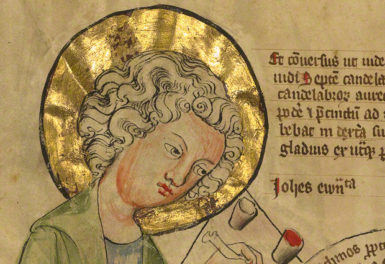
Dick Hickock, Murderer, Garden City, Kansas, April 1960, Richard Avedon, negative April 15, 1960, print 1961. Gelatin silver print, 19 9/16 × 15 11/16 in. The J. Paul Getty Museum 2000.67.6. © The Richard Avedon Foundation
The man in the photograph above is Dick Hickock, one of the murderers who was the focus of Truman Capote’s famous novel In Cold Blood. The murder of the Clutter family in Kansas was so sensational that famed photographer Richard Avedon collaborated with Capote to take portraits of both Hickock and his accomplice, Perry Smith.
Hickock is photographed in close-up, his eyes focused on something just out of view. He is clean-shaven, hair neatly slicked back, but somehow off-kilter, with a head that Capote described “as though [it] had been halved like an apple, then put together a fraction off center.”
The public has always had a morbid curiosity with the grisly and twisted, reaping profit from images of car crashes, criminals, murder scenes, and other illustrations of violence. Although the image of Hickock isn’t bloody, it is a similarly chilling depiction of criminality. It’s hard to look away.
Photographs of true crime scenes developed along with the history of photography itself, and the Getty Museum’s exhibition Unseen: 35 Year of Collecting Photographs includes two walls devoted to photographers who were not afraid to capture the dark side of humanity.
Early Crime Photographs

Alaux Case, Faubourg Saint-Honoré, 1902, Alphonse Bertillon. Gelatin silver print, 9 x 6 5/8 in. 2019.22.124. Digital image courtesy of Getty’s Open Content Program
In 2019, Getty acquired an album containing 125 photographs of crime scenes created in Paris between 1886 and 1902. The images range from graphic murders to criminal suspects to an innocuous suitcase (spoiler: the suitcase contained body parts).
This extremely rare album was assembled during the crucial development in late 19th century photographic history, when the Paris police began taking photographs for criminal investigations.

Valise, 1899, Alphonse Bertillon. Gelatin silver print, 5 1/16 x 7 in. The J. Paul Getty Museum 2019.22.14. Digital image courtesy of Getty’s Open Content Program.

Affaire Alaux, Faubourg St. Honoré—L’Assassin, 1902, Alphonse Bertillon. Gelatin silver print, 3 1/8 × 5 in. 2019.22.125. Digital image courtesy of Getty’s Open Content Program. (This image is not featured in Unseen.)
“The public fascination with sensational crime stories in the 19th century was increasingly fed by newspaper and magazine reporting as well as the new literary genre of detective fiction,” said Jim Ganz, senior curator of photographs for the Getty Museum. “At the same time, the documentation of actual crime scenes by law enforcement was dramatically enhanced by the use of photography, which became a vital component of modern forensic science.”
Paris Préfecture de Police criminologist Alphonse Bertillon was one of the first to use photography as “evidence” for police investigations. He is most likely the photographer of the crime scenes, and is credited with inventing the mugshot. These photographs of the front and profile of a suspect were pasted to a card that recorded their bodily measurements.
Bertillon believed that this card-based system, complemented by a strict photographic technique, provided portraits parlés (“speaking likenesses”) that the police could use to track and identify suspects and repeat offenders.
Starting in 1882, after instituting the newly named “anthropometry service” in the police headquarters in Paris, Bertillon built a photo studio where criminals and evidence could be recorded, and operators could be trained in the techniques of “bertillonage.” This included a system for the identification of criminals using anthropometric measurements, including head size, arm span, scars, and other distinguishing features. His influence was widespread throughout Europe, and the “système Bertillon” was in use in France until 1970.
Bertillon’s album and methods inspired the 2002 book Crime Album Stories: Paris 1886-1902 by photography historian Eugenia Parry. Parry conducted extensive research in the Préfecture de Police archives in Paris and combined many of the photographs with contemporary accounts in newspapers and court papers – a creative mixture of fiction, fact, and photographs.
“They’re beautiful. They make me sick,” Parry writes. “I read reports of the crimes in the Paris newspapers and copy surviving bits from police dossiers. All I get is facts. The pictures in the album say something else, ask me to separate the victims from the blood, to distinguish between the murderers’ wild alibis.”
Villains and Victims

Weegee, New York, 1945, Lisette Model. Gelatin silver print, 13 7/16 × 10 5/8 in. The J. Paul Getty Museum 84.XM.153.75. © Estate of Lisette Model, courtesy Baudoin Lebon/Keitelman
While mugshots have become a police standard, photographers have depicted criminals in very different ways. American photographer Weegee (born Arthur Fellig) was, according to Getty associate curator Amanda Maddox, “a gruff, cigar-chomping ambulance chaser known for documenting the grim underbelly of New York City.”
Aided by what he claimed was a Ouija board-like clairvoyance (but was more likely a police radio), Weegee would often come across fresh crimes at the same time as the police, and was able to shoot these unstaged, raw, and disturbing scenes. The exhibition includes his image of Frank Pape, a man arrested for homicide. Weegee photographed him frowning and disengaged, his head framed by a metal enclosure.

Frank Pape, Arrested for Homicide, November 4, 1944, Weegee (Arthur Fellig). Gelatin silver print, 13 5/8 x 10 9/16 in. The J. Paul Getty Museum 84.XM.862.1. © International Center of Photography
“Weegee, and other 20th century photographers such as Leonard Freed, were unflinching in their quest to document what many avoid or try to forget,” said Ganz. “Their photographs reveal much about society, about how we treat each other, and more broadly, how we are all mortal. While the images may make some uncomfortable, I hope viewers leave the exhibition with a better understanding about how photographs can be used to help us face these truths.”
Unseen: 35 Years of Collecting Photographs is on view through March 8, 2020.




Comments on this post are now closed.